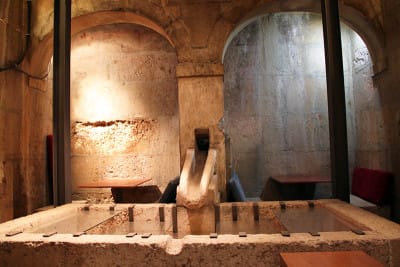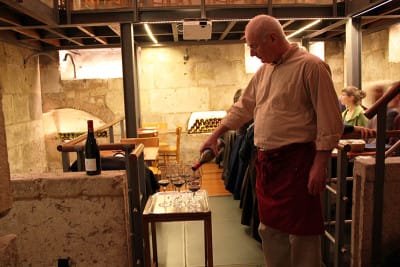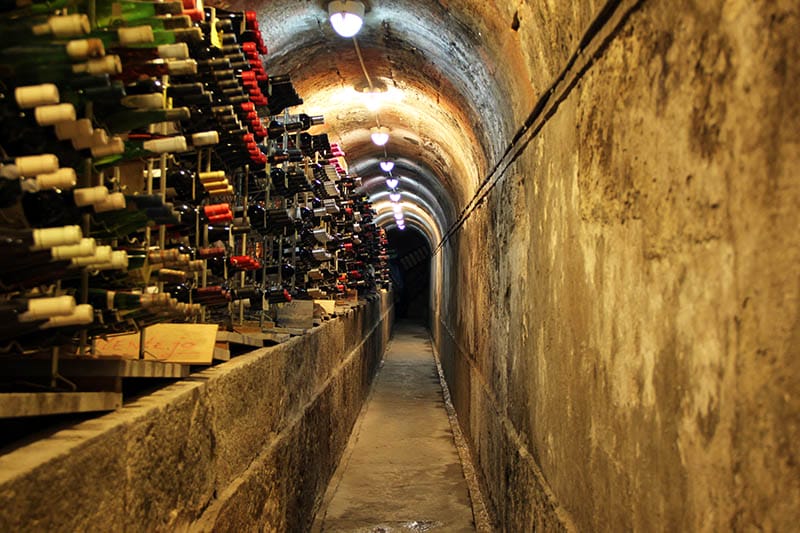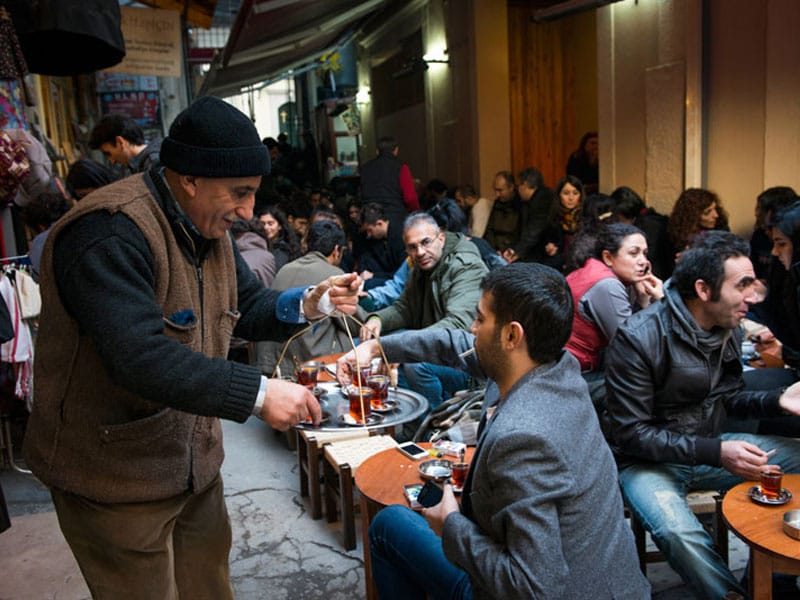Update: This spot is sadly no longer open.
Beneath modern Lisbon lies a complex network of galleries belonging to the city’s 18th-century aqueduct, a monumental structure that resisted the 1755 earthquake that devastated much of the capital. The aqueduct’s 58 km of tunnels and underground channels distributed water to 33 chafarizes (fountains) – often ornamental – to supply the city with drinking water. One of them, located along the steep steps connecting the Avenida and Príncipe Real neighborhoods, now houses Chafariz do Vinho, the Portuguese capital’s oldest enoteca, or wine bar.
Considering the historic setting, that accolade is somewhat deceptive; the business was established only in 1998, by four entrepreneurs, in agreement with City Hall. That year, Lisbon hosted a world’s fair, Expo ’98, making the clear goal of this new tasting haven the promotion of Portuguese wines. According to Tim Manfred, a German living in Lisbon who is one of Chafariz do Vinho’s co-owners, the venue was the first in the country to offer wine by the glass following the modern concept of the wine bar, which did not have a tradition in Portugal. (That said, Lisbon is filled with neighborhood bars where a quick glass of decent house wine can be quaffed, but you get what you pay for.)
 Located close to the Praça da Alegria – a small, Italian-style public garden surrounded by a strange mix of abandoned historical buildings, new hotels and old red-light bars – Chafariz do Vinho is in a quiet corner, its entrance underneath a cypress tree. Although some of the other chafarizes have been turned into historical sites to visit, this is the only one currently occupied as a business, with the dining areas built literally inside the former water cistern. Inside, customer chatter bounces off the thick stone walls amid the distant sound of pounding water. When we visited, Manfred graciously gave us the keys to the vaulted, steeply inclined galleries hidden underground, a section of which is now used as the wine cellar.
Located close to the Praça da Alegria – a small, Italian-style public garden surrounded by a strange mix of abandoned historical buildings, new hotels and old red-light bars – Chafariz do Vinho is in a quiet corner, its entrance underneath a cypress tree. Although some of the other chafarizes have been turned into historical sites to visit, this is the only one currently occupied as a business, with the dining areas built literally inside the former water cistern. Inside, customer chatter bounces off the thick stone walls amid the distant sound of pounding water. When we visited, Manfred graciously gave us the keys to the vaulted, steeply inclined galleries hidden underground, a section of which is now used as the wine cellar.
With more than 250 labels on offer, Chafariz do Vinho has attained cult status in Lisbon among those wanting to taste select wines. Many of the dusty bottles in the cellar are renowned wines, but there are also unknown labels from small local growers, which can be tried at tasting events organized by João Paulo Martins, another of the owners. Martins is a wine writer as well as a sommelier, a job that according to Manfred is erroneously envied: “Wine tastings are done early in the morning, when the body is clean and there is no influence from any food in the body.”
The extensive wine list is not a surprise. Thanks to Portugal’s heterogeneous topography and climate, several demarcated wine regions end up producing a staggering variety of tipple. Douro, a wine region that encompasses the vineyards along the northern Douro River, is not only the home of port, but is also known for robust table wine made from indigenous grapes such as touriga, roriz red, baroque and red cão. Dão is the mountainous region situated in the center of the country, known also as the Portuguese Burgundy. The ample sunshine of the southern, cork-tree-covered region of Alentejo determines the higher alcohol levels and fuller-bodied wines made there. Even the Lisbon region has its own wines – its landscape, overlooking the Tagus River, is characterized by a stable Atlantic climate, which gives the wine a fresher and more rounded taste. Here, the vineyards mainly raise foreign grape varieties, such as cabernet sauvignon.
 One Lisbon wine we tried and loved at Chafariz do Vinho, a light red Casa Cadaval Pinot Noir, was ideal for the late afternoon, thanks to its smooth, balanced mouth and subdued fruitiness compared to other domestic wines. Manfred told us that Lisbon and Alentejo are the two regions seeing the greatest increases in exports, although Portugal is one of the countries with the biggest variety in native grapes, which have gradually been ascending in international quality ratings overall.
One Lisbon wine we tried and loved at Chafariz do Vinho, a light red Casa Cadaval Pinot Noir, was ideal for the late afternoon, thanks to its smooth, balanced mouth and subdued fruitiness compared to other domestic wines. Manfred told us that Lisbon and Alentejo are the two regions seeing the greatest increases in exports, although Portugal is one of the countries with the biggest variety in native grapes, which have gradually been ascending in international quality ratings overall.
Aside from the selection of wines, many of which are affordably priced, another reason to visit Chafariz do Vinho is that its tastings are accompanied by meticulous pairing combinations: couscous with smoked duck magret covered with a sauce made of wild berries cooked in port wine; wild mushrooms filled with chouriço, muxama (dried, salt-cured tuna cut into thin slices) and dried tomatoes; or an array of Iberian cheeses. The mix of clientele includes locals, tourists and others seeking good wines and good conversation over carefully prepared delicacies. It’s not every day that you can experience all this inside a centuries-old aqueduct, to boot.
 February 11, 2013 Mustafa Amca
February 11, 2013 Mustafa Amca
The Turkish proverb “At, avrat, silah ödünç verilmez” (“neither horse, wife nor weapon […] Posted in Istanbul March 2, 2016 Shanghai’s Top 5 Hotpot Restaurants
March 2, 2016 Shanghai’s Top 5 Hotpot Restaurants
Whether you call it steamboat, hotpot, Chinese fondue or shabu shabu, one thing is […] Posted in Shanghai May 2, 2022 CB on the Road
May 2, 2022 CB on the Road
Sōsuke Hirai’s hands tilt this way and that as the machine whirrs, raining large, fine […] Posted in Tokyo
Published on March 03, 2016
Related stories
February 11, 2013
IstanbulThe Turkish proverb “At, avrat, silah ödünç verilmez” (“neither horse, wife nor weapon should be lent”) is sometimes repeated as a way to recall the nomadic warrior past of the Turks. The primal Turkish essentials are clearly stated, but what about the çay bardağı, the tea glass that has become such a ubiquitous Turkish icon?…
March 2, 2016
ShanghaiWhether you call it steamboat, hotpot, Chinese fondue or shabu shabu, one thing is certain: Nothing warms you up in the depths of winter like a steaming bowl of bone broth. As winter continues its dreary hold, here are five of the best places to get hotpot in Shanghai. Hai Di Lao With 19 locations…
May 2, 2022
Tokyo | By Florentyna Leow
TokyoSōsuke Hirai’s hands tilt this way and that as the machine whirrs, raining large, fine flakes of ice into a bowl. He pauses the machine, lightly pats the ice and taps the bowl on the counter, allowing the ice to sink and compress. A swirl of persimmon tea syrup is added to the ice. Then…



















































































